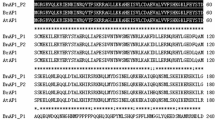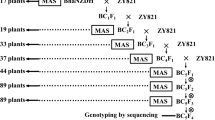Abstract
Unadapted germplasm may contain alleles that could improve hybrid cultivars of spring oilseed Brassica napus. Quantitative trait loci (QTL) mapping was used to identify potentially useful alleles from two unadapted germplasm sources, a Chinese winter cultivar and a re-synthesized B. napus, that increase seed yield when introgressed into a B. napus spring hybrid combination. Two populations of 160 doubled haploid (DH) lines were created from crosses between the unadapted germplasm source and a genetically engineered male-fertility restorer line (P1804). A genetically engineered male-sterile tester line was used to create hybrids with each DH line (testcrosses). The two DH line populations were evaluated in two environments and the two testcross populations were evaluated in three or four environments for seed yield and other agronomic traits. Several genomic regions were found in the two testcross populations which contained QTL for seed yield. The map positions of QTL for days to flowering and resistance to a bacterial leaf blight disease coincided with QTL for seed yield and other agronomic traits, suggesting the occurrence of pleiotropic or linked effects. For two hybrid seed yield QTL, the favorable alleles increasing seed yield originated from the unadapted parents, and one of these QTL was detected in multiple environments and in both populations. In this QTL region, a chromosome rearrangement was identified in P1804, which may have affected seed yield.


Similar content being viewed by others
References
Akbar MA (1989) Resynthesis of Brassica napus aiming for improved earliness and carried out by different approaches. Hereditas 111:239–246
Basten CJ, Weir BS, Zeng ZB (2002) QTL cartographer, version 1.16. Department of Statistics. North Carolina State University, Raleigh
Becker HC, Engqvist GM, Karlsson B (1995) Comparison of rapeseed cultivars and resynthesized lines based on allozyme and RFLP markers. Theor Appl Genet 91:62–67
Bernacchi D, Tanksley S (1998) Advanced backcross QTL analysis of tomato. I. Identification of QTLs for traits of agronomic importance from Lycopersicon hirsutum. Theor Appl Genet 97:381–397
Bouchez A, Hospital F, Causse M, Gallais A, Charcosset A (2002) Marker-assisted introgression of favorable alleles at quantitative trait loci between maize elite lines. Genetics 162:1945–1959
Bradshaw JE, Gemmell DJ, Wilson RN (1997) Transfer of resistance to clubroot (Plasmodiophora brassicae) to swedes (Brassica napus L var napobrassica Peterm) from B. rapa. Ann Appl Biol 130:337–348
Brondani C, Rangel PHN, Brondani RPV, Ferreira ME (2002) QTL mapping and introgression of yield-related traits from Oryza glumaepatula to cultivated rice (Oryza sativa) using microsatellite markers. Theor Appl Genet 104:1192–1203
Butruille DV, Guries RP, Osborn TC (1999a) Increasing yield of spring oilseed rape hybrids through introgression of winter germplasm. Crop Sci 39:1491–1496
Butruille DV, Guries RP, Osborn TC (1999b) Linkage analysis of molecular markers and quantitative trait loci in populations of inbred backcross lines of Brassica napus L. Genetics 153:949–964
Chen BY, Heneen WK, Jönsson R (1988) Resynthesis of Brassica napus L. through interspecific hybridization between B. alboglabra Bailey and B. campestris L. with special emphasis on seed colour. Plant Breed 101:52–59
Concibido VC, La Vallee B, Mclaird P, Pineda N, Meyer J, Hummel L, Yang J, Wu K, Delannay X (2003) Introgression of a quantitative trait locus for yield from Glycine soja into commercial soybean cultivars. Theor Appl Genet 106:575–582
Diers BW, Osborn TC (1994) Genetic diversity of oilseed Brassica napus germplasm based on restriction fragment length polymorphisms. Theor Appl Genet 88:662–668
Doerge RW, Churchill GA (1996) Permutation tests for multiple loci affecting a quantitative character. Genetics 142:285–294
Edwards AL (1976) An introduction to linear regression and correlation. WH Freeman and Company, San Francisco
Eshed Y, Zamir D (1995) An introgression line population of Lycopersicon pennellii in the cultivated tomato enables the identification and fine mapping of yield-associated QTL. Genetics 141:1147–1162
Ferreira ME, Williams PH, Osborn TC (1994) RFLP mapping of Brassica napus using F1–derived doubled haploid lines. Theor Appl Genet 89:615–621
Frary A, Fulton TM, Zamir D, Tanksley SD (2004) Advanced backcross QTL analysis of a Lycopersicon esculentum x L. pennellii cross and identification of possible orthologs in the Solanaceae. Theor Appl Genet 108:485–496
Grant M, McDowell J, Sharpe A, De Torres Zabala M, Lydiate D, Dangle J (1998) Independent deletions of a pathogen-resistance gene in Brassica and Arabidopsis. Proc Natl Acad Sci USA 95:15843–15848
Hallauer AR, Miranda JB (1988) Quantitative genetics in maize breeding. 2nd edn. Iowa State University Press, Ames
Kardailsky I, Shukla B, Ahn JH, Dagenais N, Christensen SK, Nguyen JT, Chory J, Harrison M, Weigel D (1999) Activation tagging of the floral inducer FT. Science 286:1962–1965
Kidwell KK, Osborn TC (1992) Simple plant DNA isolation procedures In: Beckman J, Osborn TC (eds) Plant genomes: methods for genetic and physical mapping. Kluwer, Dordrecht, pp 1–13
Knapp SJ, Stroup WW, Ross WW (1985) Exact confidence intervals for heritability on a progeny mean basis. Crop Sci 25:192–194
Kole C, Kole P, Vogelzang R, Osborn TC (1997) Genetic linkage map of a Brassica rapa recombinant population. J Hered 88:553–557
Kole C, Quijada P, Michaels SD, Amasino R, Osborn TC (2001) Evidence for homology of flowering-time genes VFR2 from Brassica rapa and FLC from Arabidopsis thaliana. Theor Appl Genet 102:425–430
Kräling K (1987) Utilization of genetic variability of resynthesized rapeseed. Plant Breed 99:209–217
Lefort-Buson M, Guillot-Lemoine B, Dattee Y (1987) Heterosis and genetic distance in rapeseed (Brassica napus L.): crosses between European and Asiatic selfed lines. Genome 29:413–418
Littell RC, Milliken GA, Stroup WW, Wolfinger RD (1996) SAS system for mixed models. SAS Inst., Cary
Liu B (1997) Statistical genomics linkage, mapping and QTL analysis. CRC Press, Boca Raton
Manzanares-Dauleux MJ, Delourme R, Baron F, Thomas G (2000) Mapping of one major gene and of QTLs involved in resistance to clubroot in Brassica napus. Theor Appl Genet 101:885–891
Mariani C, De Beuckeler M, Truettner J, Leemans J, Goldberg RB (1990) Induction of male sterility in plants by a chimaeric ribonuclease gene. Science 347:737–741
Mariani C, Gossele V, De Beuckeler M, De Block M, Golberg RB, De Greef W, Leemans J (1992) A chimaeric ribonuclease inhibitor gene restores fertility to male sterile plants. Nature 357:384–387
Mode CJ, Robinson HF (1959) Pleiotropism and the genetic variance and covariance. Biometrics 15:518–537
Moncada P, Martinez C, Borrero J, Chatel M, Gauch Jr. H, Guimaraes E, Tohme J, McCouch S (2001) Quantitative trait loci for yield and yield components in an Oryza sativa x Oryza rufipogon BC2F2 population evaluated in a upland environment. Theor Appl Genet 102:41–52
Morgan CL, Bruce DN, Child R, Ladbrooke ZL, Arthur AE (1998) Genetic variation for pod shatter resistance among lines of oilseed rape developed from synthetic B. napus. Field Crops Res 58:153–165
Morrison MJ, Stewart DW (2002) Heat stress during flowering in summer Brassica. Crop Sci 42:797–803
Osborn TC, Kole C, Parkin IAP, Kuiper M, Lydiate DJ, Trick M (1997) Comparison of flowering time genes in Brassica rapa, B napus, and Arabidopsis thaliana. Genetics 146:1123–1129
Osborn TC, Butruille DV, Sharpe AG, Pickering KJ, Parkin IAP, Parker JS, Lydiate DJ (2003) Detection and effects of a homoeologous reciprocal transposition in Brassica napus. Genetics 165:1569–1577
Parkin IAP, Sharpe AG, Keith DJ, Lydiate DJ (1995) Identification of the A and C genomes of amphidiploid Brassica napus (oilseed rape). Genome 38:1122–1131
Parkin IAP, Lydiate DJ, Trick M (2002) Assessing the level of collinearity between Arabidopsis thaliana and Brassica napus for A. thaliana chromosome 5. Genome 45:1–11
Pillen K, Zacharias A, Leon J (2003) Advanced backcross QTL analysis in barley (Hordeum vulgare L.). Theor Appl Genet 107:340–352
Prakash S, Chopra VL (1990) Reconstruction of allopolyploid Brassicas through non-homologous recombination: introgression of resistance to pod shatter in B. napus. Genet Res Camb 56:1–2
Quijada P, Mauriera I, Osborn TC (2004a) Confirmation of QTL controlling seed yield in spring canola (Brassica napus) hybrids. Mol Breed 13:193–200
Quijada PA, Udall JA, Polewicz H, Osborn TC (2004b) Phenotypic effects of introgressing French winter germplasm into hybrid spring canola (Brassica napus L.). Crop Sci 44:1982–1989
Quijada PA, Udall JA, Lambert B, Osborn TC (2006) Identification of genomic regions from winter germplasm that affect seed yield and other complex traits in hybrid spring rapeseed (Brassica napus L.). Theor Appl Genet (in press)
Rice W (1989) Analyzing tables of statistical tests. Evolution 43:223–225
Ratcliffe O, Kumimoto RW, Wong BJ, Riechmann JL (2003) Analysis of the Arabidopsis MADS AFFECTING FLOWERING gene family: MAF2 prevents vernalization by short periods of cold. Plant Cell 15:1159–1169
SAS Institute (2000) SAS/STAT® User’s guide, version 8. SAS Inst, Cary
Scarth R, Rimmer SR, McVetty PBE (1992) Reward summer turnip rape. Can J Plant Sci 72:839–840
Schranz ME, Quijada P, Sung SB, Lukens L, Amasino R, Osborn TC (2002) Characterization and effects of the replicated flowering time gene FLC in Brassica rapa. Genetics 162:1457–1468
Sharpe AG, Parkin IAP, Keith DJ, Lydiate DJ (1995) Frequent nonreciprocal translocations in the amphidiploid genome of oilseed rape (Brassica napus). Genome 38:1112–1121
Sillito D, Parkin IAP, Mayerhofer R, Good AG (2000) Arabidopsis thaliana: A source of candidate disease–resistance genes for Brassica napus. Genome 43:452–460
Song K, Osborn TC, Williams PH (1993) Development of synthetic Brassica amphidiploids by reciprocal hybridization and comparison to natural amphidiploids. Theor Appl Genet 89:885–894
Tanksley SD, Grandillo S, Fulton T, Zamir D, Eshed Y, Petiard V, Lopez J, Beck-Baum T (1996) Advanced backcross QTL analysis in a cross between an elite processing line of tomato and its wild relative L. pimpinellifolium. Theor Appl Genet 92:213–224
Teutonico RA, Osborn TC (1994) Mapping of RFLP and qualitative trait loci in Brassica rapa and comparison to the linkage maps of Brassica napus, Brassica oleracea, and Arabidopsis thaliana. Theor Appl Genet 89:885–894
Thormann CE, Romero J, Mantet J, Osborn TC (1996) Mapping loci controlling the concentrations of erucic and linolenic acids in seed oil of Brassica napus L. Theor Appl Genet 93:282–286
Toroser D, Thormann CE, Osborn TC, Mithen R (1995) RFLP mapping of quantitative trait loci controlling seed aliphatic–glucosinolate content in oilseed rape (Brassica napus L.). Theor Appl Genet 91:802–808
Udall JA, Quijada PA, Polewicz H, Vogelzang R, Osborn TC (2004) Phenotypic effects of introgressing Chinese winter and resynthesized Brassica napus L. germplasm into hybrid spring canola. Crop Sci 44:1990–1996
Udall JA, Quijada PA, Osborn TC (2005) Detection of chromosomal rearrangements derived from homoeologous recombination in four mapping populations of Brassica napus L. Genetics 169:967 –979
van Ooijen JW, Voorrips RE (2001) JoinMap® Version 3.0, Software for the calculation of genetic linkage maps. Plant Research International, Wageningen, The Netherlands
Xiao J, Li J, Grandillo S, Sang-Nag A, Yuan L, Tanksley S, McCouch S (1998) Identification of trait-improving quantitative trait loci alleles from a wild rice relative, Oryza rufipogon. Genetics 150:899–909
Yuanhui H, Xiufang C (1989) The significance and application of multiple resistance (tolerance) of a new variety-Zhongyou 821 of oilseed rape. Chin oilseed crops 3:1–5
Acknowledgements
We thank researchers at Bayer CropScience for their assistance, particularly Tom Schuler, Stewart Brandt, and Hieronim Polewicz for seed production and field trials, and Debbie Doell for microspore culture and plantlet development. We also thank Robert Vogelzang for his technical assistance. JAU was funded in part by UW Pioneer Plant Breeding Fellowship 1999–2000 and PAQ was funded by a scholarship from Consejo de Desarrollo Científico y Humanístico, Universidad Central de Venezuela, Government of Venezuela. Additional funding was provided by North Central Biotechnical Initiative and USDA-NRI grant # 98–353006–6286 to T.C.O.
Author information
Authors and Affiliations
Corresponding author
Additional information
Communicated by S. J. Knapp
Electronic supplementary material
Rights and permissions
About this article
Cite this article
Udall, J.A., Quijada, P.A., Lambert, B. et al. Quantitative trait analysis of seed yield and other complex traits in hybrid spring rapeseed (Brassica napus L.): 2. Identification of alleles from unadapted germplasm. Theor Appl Genet 113, 597–609 (2006). https://doi.org/10.1007/s00122-006-0324-0
Received:
Accepted:
Published:
Issue Date:
DOI: https://doi.org/10.1007/s00122-006-0324-0




